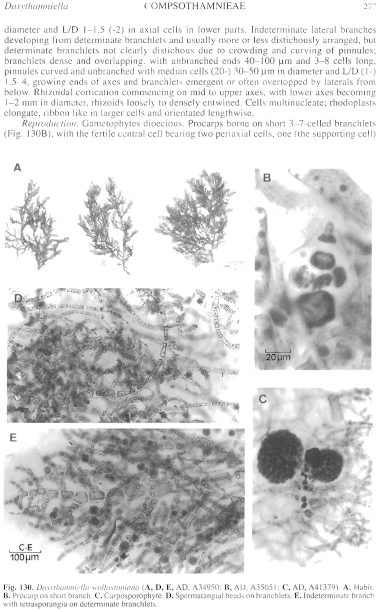|
|
|
|
|
|||||||||||
|
Electronic Flora of South Australia Species Fact Sheet
Phylum Rhodophyta – Order Ceramiales – Family Ceramiaceae – Tribe Compsothamnieae
Synonyms
Callithamnion wollastonianum Harvey 1855a: 561; 1863: lii. J. Agardh 1876: 48. Sonder 1881: 10.
Spongoclonium wollastonianum (Harvey) J. Agardh 1892: 41. De Toni 1903: 1358. Lucas 1909: 49; 1927: 465.
Spongoclonium wilsonianum J. Agardh 1892: 42. De Toni 1903: 1359. Lucas 1909: 49; 1927: 465, p1. 30.
Thallus (Fig. 130A) erect, spreading, medium to dark red-brown, 5–15 cm high with 1–3 corticate main axes and prominent spreading, corticate lateral branches 1–5 cm long, with dense, overlapping lateral branchlets. Holdfast 2–8 mm across, rhizoidal; epilithic or epiphytic. Structure. Branching at apices (Fig. 130E) alternate and distichous, apical cells dividing slightly to distinctly obliquely, increasing from 10–25 µm in diameter and L/D 1–2 to 200–500 µm in diameter and L/D 1–1.5 (–2) in axial cells in lower parts. Indeterminate lateral branches developing from determinate branchlets and usually more or less distichously arranged, but determinate branchlets not clearly distichous due to crowding and curving of pinnules; branchlets dense and overlapping, with unbranched ends 40–100 µm and 3–8 cells long, pinnules curved and unbranched with median cells (20–) 30–50 µm in diameter and L/D (1–) 1.5–4, growing ends of axes and branchlets emergent or often overtopped by laterals from below. Rhizoidal cortication commencing on mid to upper axes, with lower axes becoming 1–2 mm in diameter, rhizoids loosely to densely entwined. Cells multinucleate; rhodoplasts elongate, ribbon like in larger cells and orientated lengthwise.
Reproduction: Gametophytes dioecious. Procarps borne on short 3–7-celled branchlets (Fig. 130B), with the fertile central cell bearing two periaxial cells, one (the supporting cell)
Type from Middleton Bay, King George Sound, W. Aust.; holotype in TCD (Harvey, Tray. Set 329).
Selected specimens: Waldegrave I., S. Aust., 22 m deep (Shepherd, 23.x.1970; AD, A37399). Elliston, S.Aust., 10–12 m deep in bay (Shepherd, 24.x.1969; AD, A34950) and 10–11 m deep in bay (Shepherd, 20.x.1969; AD, A35051). Stenhouse Bay, S. Aust., 3–7 m deep (Kraft, 18.ix.1973; AD, A44558) and 3–4 m deep on jetty piles (Cannon, 15.x.1988; AD, A59180). Point Turton, S. Aust., drift (Womersley, 16.x.1988; AD, A59134). Port Victoria, S. Aust., 3–4 m deep (Kraft, 20.ix.1973; AD, A44556). Toad Head, West I., S. Aust., 22–27 m deep (Shepherd, 15.i.1966; AD, A30135). Pennington Bay, Kangaroo I., S. Aust., drift (Kraft & Min Theirs, 3.xii.1971; AD, A41379). Port MacDonnell, S. Aust., drift (Womersley, 29.ix.1996; AD, A66626). Queenscliff, Vic., 4–5 m deep (Kraft 9592 & Saunders, 9.ix.1993; MELU and AD, A67828). Portsea, Vic., on jetty piles, 3–5 m deep (Kraft 10866, O'Brien & Phillips, 24.xi.1997; MELU and AD, A67826).
Distribution: King George Sound, W. Aust., to Port Phillip Heads, Victoria.
Taxonomic notes: cutting off a terminal sterile cell and a 4-celled carpogonial branch, the other periaxial cell forming a short sterile branchlet of 2–4 cells. The auxiliary cell cuts off 3–4 successive gonimolobe initials giving rounded groups 100–200 µm across (Fig. 130C) of ovoid carposporangia 10–15 µm across; basal carposporophyte cells fuse and enlarge, with broader pit connections. Curved branchlets from cells below the carposporophyte form an involucre. Spermatangial heads (Fig. 130D) are borne adaxially on lower cells of branchlets, ovoid, 12–22 µm in diameter and L/D 2–3.
Tetrasporangia (Fig. 130E) adaxial on pinnules of branchlets, pedicellate, subspherical, 25–45 µm in diameter, tetrahedrally divided.
The type material of S. wilsonianum J. Agardh, from Port Phillip Heads, Vic. (Wilson), in LD (18688), includes two specimens and appears to be identical with S. wollastonianum. J. Agardh had previously referred these specimens to the latter species, and his description separates S. wilsonianum only on superficial characters. Specimens of D. wollastoniana show the typical reproductive features of Dasythamniella, but differ in habit from D. latissima.
References:
AGARDH, J.G. (1876). Species Genera et Ordines Algarum. Vol. 3, Part 1- Epicrisis systematic Floridearum, pp. i-vii, 1–724. (Weigel: Leipzig.)
AGARDH, J.G. (1892). Analecta Algologica. Acta Univ. lund. 28, 1–182, Plates 1–3.
DE TONI, G.B. (1903). Sylloge Algarum omnium hucusque Cognitarum. Vol. 4. Florideae. Sect. 3, pp. 775–1521 + 1523–1525. (Padua.)
HARVEY, W.H. (1855a). Some account of the marine botany of the colony of Western Australia. Trans. R. Jr. Acad. 22, 525–566.
HARVEY, W.H. (1863). Phycologia Australica. Vol. 5, Plates 241–300, synop., pp. i-lxxiii. (Reeve: London.)
LUCAS, A.H.S. (1909). Revised list of the Fucoideae and Florideae of Australia. Proc. Linn. Soc. N.S.W. 34, 9–60.
LUCAS, A.H.S. (1927). Notes on Australian marine algae. IV. The Australian species of the genus Spongoclonium. Proc. Linn. Soc. N.S.W. 52, 460–470, Plates 27–35.
SONDER, O.W. (1881). In Mueller, F., Fragmenta Phytographiae Australiae. Supplementum ad volumen undecinum: Algae Australianae hactenus cognitae, pp. 1–42, 105–107. (Melbourne.)
The Marine Benthic Flora of Southern Australia Part IIIC complete list of references.
Publication:
Womersley, H.B.S. (24 December, 1998)
The Marine Benthic Flora of Southern Australia
Rhodophyta. Part IIIC. Ceramiales – Ceramiaceae, Dasyaceae
©State Herbarium of South Australia, Government of South Australia
Illustration in Womersley Part IIIA, 1998: FIG. 130.

Figure 130 enlarge
Fig. 130. Dasythamniella wollastoniana (A, D, E, AD, A34950; B, AD, A35051; C, AD, A41379). A. Habit. B. Procarp on short branch. C. Carposporophyte. D. Spermatangial heads on branchlets. E. Indeterminate branch with tetrasporangia on determinate branchlets.

|
Email Contact: State Herbarium of South Australia |

|